By: Katsushika Hokusai
Week: 1
In 'The Great Wave off Kanagawa,' Katsushika Hokusai printed a rogue wave looming over men in boats near Kanagawa, Japan. In the background, the serene Mount Fuji watches the life-and-death struggle of the men. 'The Great Wave off Kanagawa' is a woodblock print. Rather than being painted directly upon paper with a brush, the image is carved in relief from wood, similar to a rubber stamp. Ink is applied to the wooden block, and then the block is pressed upon paper. This work falls into an art genre called ukiyo-e, which features images such as beautiful ladies, sumo wrestlers, folk stories, and landscapes.

By: Katsushika Hokusai
Week: 2
In 'Moonlight on the Yodo River,' Katsushika Hokusai printed a busy river scene in Osaka, Japan. Men labor in boats on the river, which flows past Osaka Castle and turns a water wheel. The moon shines down from the sky. On the far side of the river, mountains spread across the horizon. Triangular rooftops of homes peek from the treetops. People stroll along a river path. Like 'The Great Wave off Kanagawa,' this work is a woodblock print. Rather than being painted directly upon paper with a brush, the image is carved in relief from wood, similar to a rubber stamp. Ink is applied to the wooden block, and then the block is pressed upon paper.

By: Katsushika Hokusai
Week: 3
Katsushika Hokusai's 'Tenma Bridge in Setsu Province' shows a throng of people crossing the graceful arch of a lantern-lit bridge. More lanterns light a fleet of boats being pushed by polemen below. Warm light shines from the windows of the homes on the river. Roofs peep through the foliage in the foreground. Like 'The Great Wave off Kanagawa,' this work is a woodblock print. Rather than being painted directly upon paper with a brush, the image is carved in relief from wood, similar to a rubber stamp. Ink is applied to the wooden block, and then the block is pressed upon paper.
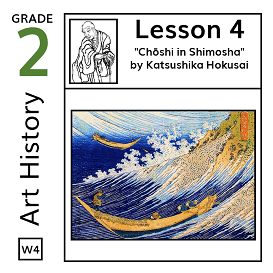
By: Katsushika Hokusai
Week: 4
Katsushika Hokusai's 'Chōshi in Shimosha' shows boats near the beach of the city of Chōshi in Japan. Men in the boats hunch over and pull their paddles through the seawater. The steep waves churn up seafoam and threaten to dash the boats upon the beach. Like 'The Great Wave off Kanagawa,' this work is a woodblock print. Rather than being painted directly upon paper with a brush, the image is carved in relief from wood, similar to a rubber stamp. Ink is applied to the wooden block, and then the block is pressed upon paper.
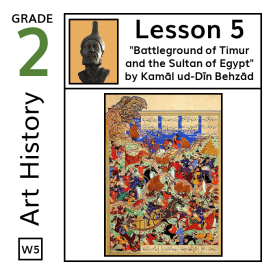
By: Kamāl ud-Dīn Behzād
Week: 5
In Kamāl ud-Dīn Behzād's battle scene, 'Battleground of Timur and the Mamluk Sultan of Egypt,' a chaotic tangle of armed forces collide in a riot of shapes and colors. Cavalry soldiers and foot soldiers battle for their lives, while flag bearers hoist their banners high, and musicians trumpet horns in the background. Horses and men alike are clad in brightly colored armor. Weaponry includes swords, spears, bows, and arrows. Note the spiral swirl of the clouds, the red and brown trees, the small tufts of grass, and the rock outcropping in the upper left corner that seems to claw at the men. The painting captures the historical event of 'Timur the Lame,' the Mongol conqueror, defeating the Mamluk Sultan Nasir-ad-Din Faraj outside the city of Damascus in 1400.

By: Kamāl ud-Dīn Behzād
Week: 6
Kamāl ud-Dīn Behzād's 'The Construction of Castle Khavarnaq' shows a group of men building a castle in the ancient city of al-Hira, Iraq (now Kufa, Iraq). Laborers dig in the earth, carry and dig rocks, climb ladders, stand on scaffolding, and add stones to the castle. One man pulls on a rope to raise a basket held aloft by another man. Many men wear head coverings, including turbans.
By: Kamāl ud-Dīn Behzād
Week: 7
Kamāl ud-Dīn Behzād's 'The Hunting Ground' shows a group of men hunting deer, rabbits, and other animals using bows, arrows, and spears. Birds soar in the blue sky overhead. A dog trots next to one of the hunters. Trees, bushes, and flowers dot the landscape. Rocky outcroppings sprout in the background. The trees have lost their leaves, perhaps signifying the autumn season. On the bottom right, a man holds a sun parasol to shade a man on horseback. Many men wear head coverings, including turbans.
By: Kamāl ud-Dīn Behzād
Week: 8
Kamāl ud-Dīn Behzād's 'Yusef and Zulaikha (Joseph chased by Potiphar's wife)' depicts a scene from the Bible and the Quran. The painting shows a cross-sectional view of a building, with the beautiful Zulaikha kneeling and clutching at the handsome Yusef. Some people believe the story of Yusef and Zulaikha is symbolic of the soul's longing for the divine.
By: Ancient Egyptian Artists
Week: 9
The 'Golden Mask of Tutankhamun' shows the death mask of the ancient Egyptian Pharaoh Tutankhamun that was discovered in a tomb in 1925. The mask is made from gold, colored glass, and gemstones. Did you know the mask may not have been intended for Tutankhamun? The name of Queen Neferneferuaten was inscribed inside the mask. Tutankhamun's headcloth features a cobra, the royal Egyptian insignia, and a vulture, representing Tutankhamun's rule of Egypt.
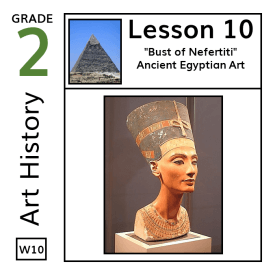
By: Thutmose
Week: 10
The Nefertiti Bust is a sculpture of Nefertiti, wife of the Egyptian Pharaoh Akhenaten. The ancient Egyptian Thutmose created the bust out of limestone, coated it with stucco, and then painted the details over the stucco. Quartz and beeswax were also used to make the bust. Nefertiti wears a flowered collar around her neck and a blue crown decorated with a cobra. Due to the popularity of the bust, Nefertiti serves as an icon of ancient Egyptian feminine beauty. The Nefertiti Bust is currently on display in Germany, however some believe it should be repatriated to Egypt.
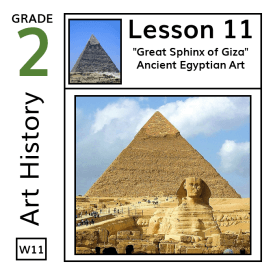
By: Ancient Egyptian Artists (photo Hamish2k)
Week: 11
The Great Sphinx of Giza is a monumental sculpture of a sphinx found in Giza, Egypt. A 'sphinx' is a fantastical creature that merges a human head and a lion's body. The Great Sphinx of Giza has the face of Pharaoh Khafre, and it is believed to have been built during his reign. Like the bust of Nefertiti, the Sphinx is made from limestone. Workers carved the Sphinx out of an existing rock formation. The image also shows tourists milling around the site and a pyramid pointing toward the white clouds and blue sky.

By: Ancient Egyptian Artists
Week: 12
The wall painting from the tomb of Ancient Egyptian artisan Sennedjem, 'Anubis Attending the Mummy of Sennedjem,' shows Anubis, Egyptian god of the afterlife and mummification, leaning over the mummy of Sennedjem. Ancient Egyptians believed that Anubis helped to guide the dead and protected cemeteries and burial grounds. Anubis appears either as a canine (e.g. wolf, jackal) or a canine head with a human body. The far-left of the painting is lined with hieroglyphics.
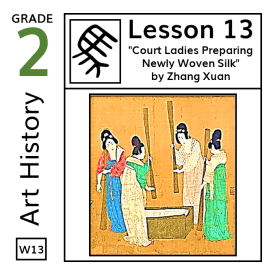
By: Zhang Xuan
Week: 13
'Court Ladies Preparing Newly Woven Silk' is the only existing copy of a painting originally created by Chinese artist, Zhang Xuan. In ancient times, the ladies of the Chinese imperial court held an annual spring silk production ceremony. On the far left of the painting, ladies hold a long length of silk while two young girls watch. Just to the right, another lady crouches near a fire heating a paddle. In the center, two seated women sew. On the far right, ladies use poles to pound silk cloth.
By: Zhang Xuan
Week: 14
Zhang Xuan's 'Spring Outing of the Tang Court' shows men and women of the Tang Court riding horses and enjoying the pleasant spring weather. 'Tang' refers to a Chinese dynasty, or line of hereditary Chinese rulers from long ago. One woman rides with a small child. This work incorporates shades of pinks and greens, perhaps reflecting the theme of spring. Chinese symbols decorate the background of the painting.

By: Zhang Shengwen
Week: 15
Zhang Shengwen's 'Kingdom of Dali Buddhist Volume of Paintings' is a scroll that stretches over 54 feet long. The small section featured in this lesson shows students surrounding Buddha, a teacher and sage of the Buddhist Religion. Halos encircle the heads of Buddha and his students. Flowers, decorations, and elaborate chandeliers adorn the painting. Equal numbers of similarly positioned students flank Buddha on both sides, bringing a sense of balance to the work. Buddhists and other religions make hand gestures called 'mudras,' which symbolize concepts such as charity, teaching, and balance. Note that Buddha in this painting raises one hand and extends his index finger, pinkie finger, and thumb, which may symbolize protection against evil. The other hand resting in his lap also makes a gesture, which is hard to discern. Today, people who practice Yoga often form mudras as they meditate.
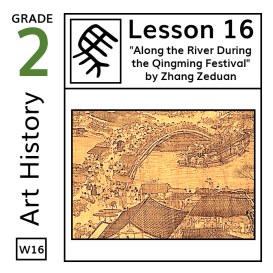
By: Zhang Zeduan
Week: 16
Zhang Zeduan's panorama, 'Along the River During the Qingming Festival,' captures an ancient Qingming Festival, a yearly celebration people hold in early April to honor their ancestors. The Qingming festival, also known as Tomb-Sweeping Day, is still held in parts of Asia today. People visit the graves of their ancestors, where they pray and offer the dead chopsticks, joss paper, tea, and food. Celebrants also eat qingtuan, special green dumplings made of rice and barley grass. This lesson features a small section of a reproduction of Zeduan's original painting. The section depicts a Qingming celebration in the city of Kaifeng, China. The river scene is busy feast for the eye. People bustle about their business, strolling, working, and lounging. Sailors on a boat lower a mast to pass under a bridge. A long line of men pull the boat forward using ropes. Other men balance under the bridge and use poles to guide the boat.
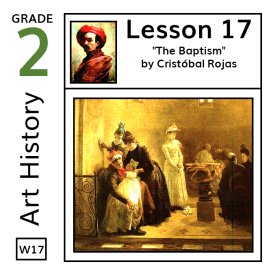
By: Cristóbal Rojas
Week: 17
Venezuelan painter Cristóbal Rojas' 'The Baptism' features a scene in a church baptistry. Three women in hats and dresses surround a red-faced, squalling infant wearing a white baptismal gown and bonnet. Behind the group, a ghostly woman in white stands with a white bouquet at her feet. Even further back a priest wearing a white robe sits with his head bent toward another man. A bald man and a stern-looking woman in somber black sit and have a private discussion. Features of the room include a central baptism font of holy water, a swirling wrought iron railing, and a floor design incorporating crosses, squares, and a ring encircling the baptism font.

By: Cristóbal Rojas
Week: 18
'Dante and Beatrice on the Banks of the Lethe' by Cristóbal Rojas features a scene from Dante Alighieri's narrative poem, 'Divine Comedy.' In the poem, Dante imagines himself traveling through Hell, Purgatory, and Paradise (Heaven). The character of Beatrice is likely inspired by a real woman named Beatrice Portinari. Beatrice Portinari was Dante's lifelong love and muse, even though they only spoke twice. The painting depicts Dante, Beatrice, and many Nymphs near the Lethe River. The scene glows with light, and beautiful flowers flourish on the riverbanks. According to legend, all who drink of the Lethe suffer complete forgetfulness. In 'Divine Comedy,' Dante submerges into the river and suffers amnesia.
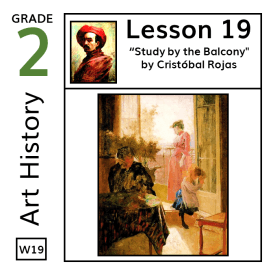
By: Cristóbal Rojas
Week: 19
Cristóbal Rojas' 'Study by the Balcony' shows a little girl in a dress running inside from a balcony. A woman in pink stands on the balcony and looks over the side, enjoying the bright, sunny day. Another person in black sits at a table covered with a black and pink tablecloth.

By: Cristóbal Rojas
Week: 20
In Cristóbal Rojas' 'The First and Last Communion,' a woman gazes tenderly down at a little girl as a priest and his altar boy hold communion. A man, head in hand, and a boy sit in the shadows behind the woman. Wearing a glowing white communion gown, the little girl huddles on a chair, her pallor indicative of tuberculosis. The painting title indicates that the girl is very sick and will not live long. A bed is visible to the right, hinting that they are in the little girl's bedroom. She is probably too weak to travel to the church, which is why the priest and altar boy traveled to her home. A day which should be joyous, is instead a reminder of what has been and will be lost.

By: Raja Ravi Varma
Week: 21
Raja Ravi Varma's painting, 'Lakshmi,' features Lakshmi, the Hindu goddess of fortune and prosperity. According to legend, Lakshmi floated into the universe on a lotus flower. This is reflected in the painting, where Lakshmi stands on a lotus flower over a small pool of water. She wears an intricate headdress, a pink sari, and jewelry at her ears, wrists, upper arms, and neck. A small red dot, or bindi, marks her forehead, often used to signify an Indian woman is married. Lakshmi holds lotus flowers in two of her four hands. Swans float to the left among even more lotus flowers. An elephant, a sacred animal in Hinduism, holds a wreath of flowers in its trunk. In the background, a small waterfall fills the pool from under soaring mountain peaks.
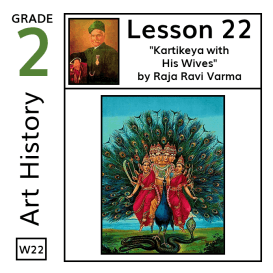
By: Raja Ravi Varma
Week: 22
Raja Ravi Varma's 'Kartikeya with His Wives' depicts Kartikeya, the Hindu god of victory and war. In legends, Kartikeya fights evil and is a source of good. In the painting, he and his wives ride a glorious peacock, which steps on a hooded cobra slithering below. Each of Kartikeya's wives holds a flower. Kartikeya has six heads, allowing him to see enemies approaching from every direction during war. Kartikeya holds various weapons in his twelve hands, including a scimitar. Kartikeya also has twelve feet, although it is not shown in the painting. Legend explains why Kartikeya has six heads and a dozen hands and feet. Kartikeya's mother had six babies and hugged them so hard, the bodies merged, leaving the heads, hands, and feet separate.
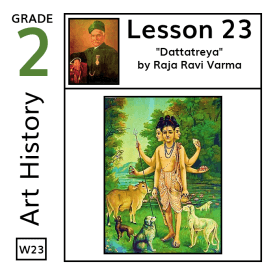
By: Raja Ravi Varma
Week: 23
Raja Ravi Varma's 'Dattatreya' shows the Hindu monk and deity, Dattatreya, standing on a peaceful riverbank. He is surrounded by a cow and four dogs. The cow symbolizes mother earth, and the four dogs symbolize the four Vedas (Hindu scriptures). As an avatar of three Hindu gods, Brahma, Vishnu, and Shiva, Dattatreya is shown with three heads and six arms. Dattatreya has a rosary and water pot for Brahma, a conch and wheel for Visnu, a trident and drum for Shiva, and a lotus for both Vishnu and Brahma.
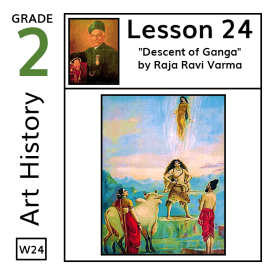
By: Raja Ravi Varma
Week: 24
Raja Ravi Varma's, 'Descent of Ganga' shows the Ganges River personified as the Hindu river goddess Ganga descending from the heavens. Shiva stands directly beneath Ganga, with Parvati (the female mother goddess), Nandi (the bull ridden by Shiva), and Bhagiratha (the male king) watching from below. Bhagiratha was a king who brought Ganga down through prayer and self-discipline. The waters of the Ganges River are considered sacred by Hindus.
By: Tom Roberts
Week: 25
Tom Roberts' 'A break away!' shows a drover leaning off a horse and waving his hat at a thirsty herd of sheep stampeding toward a waterhole. The drover tries to slow or scatter the sheep to save them from trampling each other to death. Suffering from a drought, the land is brown and dry. Great clouds of dust fill the air, almost obscuring a second drover and a dog. Two birds soar nearby, watching the chaos and perhaps hoping for a meal of carrion.

By: Tom Roberts
Week: 26
Tom Roberts' 'Bailed Up' shows Australian bushrangers holding up a stage coach. A hill climbs high in the background, making it private and closed in, a good place for an ambush. The ground is brown and dusty. A fallen log blocks the road, probably positioned by the bushrangers. Roberts modeled the painting location on a real place in Australia. Roberts based the characters on real people he saw in the area. It took Roberts over twenty years to sell the painting. No one wanted it. Today, a former curator of the Australian museum hosting the painting called it, 'the greatest Australian landscape ever painted.'
By: Tom Roberts
Week: 27
Tom Roberts' 'Shearing the Rams' shows sheep shearers shearing sheep in a shearing shed. To create this work, Roberts spent two years at a sheep station and used a real shearing shed as a model. Roberts made around 80 sketches before starting to paint on canvas. Roberts painted this work in an impressionistic style.
By: Tom Roberts
Week: 28
Tom Roberts' 'Coming South' shows migrants traveling south by steamship from Europe to Australia. Like the migrants in the painting, Roberts himself migrated from England to Australia as a boy. As a man, Roberts made the trip south again after studying art in Europe. Roberts painted 'Coming South' based on sketches he made during that voyage. In the painting, women and men sit on deck, enjoying the daylight, as they make the long journey. A smokestack puffs black smoke in the background. A variety of rigging, such as ropes and cables, stretch here and there.
By: Diego Rivera
Week: 29
Diego Rivera's 'Knife and Fruit in Front of the Window' pairs still life with cityscape. In the foreground, a table supports a bowl of fruit, some scattered fruit, an empty bottle, and a knife. Outside the second story window, the gaze of the viewer skips across rooftops to alight on row houses and other buildings in the city.
By: Diego Rivera
Week: 30
Diego Rivera's 'Zapatista Landscape (The Guerrilla),' painted in 1915, captures the mood of the Mexican revolution. Rivera uses a black sombrero (hat), rifle, brightly colored serape, and cartridge belt to suggest a Guerrilla figure. Grey mountains soar to points in the background. An unfolded piece of paper and nail are at the lower right. The geometric shapes and disjointed views reveal this work as an example of cubism.
By: Diego Rivera
Week: 31
Diego Rivera's 'The Alarm Clock' features a cubist perspective of items including an alarm clock, a guitar, and a design featuring the four card suites: spades, hearts, clubs, and diamonds. Bright colors and lines intersect throughout the work. The objects are fractured, painted from multiple perspectives.
By: Diego Rivera
Week: 32
Diego Rivera's 'Two Women' depicts a cubist perspective of two well-dressed women with coiffed hair. One woman in white reclines in a chair and holds a book. The other woman in blue stands with her hands folded. Abstract shapes predominate the rest of the painting. Squares, rectangles, triangles, staircases, and other forms can be seen, some shaded to suggest a three-dimensional perspective.
By: Gerard Sekoto
Week: 33
Gerard Sekoto's 'Horse and Cart. Sophiatown' shows a busy day in the city of Sophiatown. A man riding on a cart raises a whip as the white horse pulling the cart balks. To the right, a woman balances a white bundle on her head. Various people walk the streets and ride bicycles. Power lines stretch between poles that recede into the distance. Rooftops stretch to the horizon.
By: Gerard Sekoto
Week: 34
Gerard Sekoto's 'The Soccer Players' shows a woman with an infant snuggled against her back. She watches a field full of young children playing a soccer game, possibly imagining her own child growing up healthy and strong and playing soccer someday. On the soccer field, children sprint at the soccer ball while the goalkeeper watches intently from the goal. A young boy standing behind the woman also watches the soccer game and may be longing to join the fun.
By: Gerard Sekoto
Week: 35
Gerard Sekoto's 'Vermeulen Street, Pretoria' shows a busy city street. A corner clothing store, 'AEG Capital Outfitters,' serves as a backdrop for people walking, driving, and bicycling. One woman carries a basket, and another balances a bundle on her head. A man in a long coat rides a bicycle. Sidewalks and green trees line the streets.

By: Gerard Sekoto
Week: 36
Gerard Sekoto's 'Yellow Houses: District Six' shows people in Cape Town, South Africa, relaxing on semiprivate patios. They lounge outside their bright yellow homes to escape the heat. To the far left, a young girl reaches up, perhaps stretching or trying to peek over the wall. A woman in white holds an infant while another person sits on the curb. A man leans against a wall, relaxing with his hat pulled down over his face. To the far right, two women stroll down the street. District Six became notorious in the late 1960s, when government officials declared it a whites-only area. Over 60,000 of its non-white residents were forcibly removed from their homes to enforce a policy of apartheid.